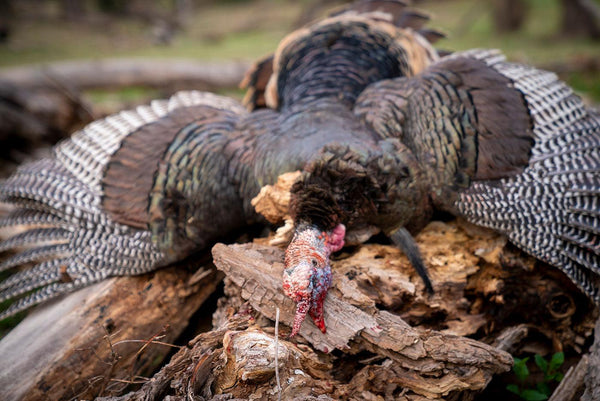Turkey Calling Tips: Basic Calling Tips & Tools
Mar 31, 2022
Let's talk about turkey calling tips. I’m set up here and have everything laid out the way I would be if I were sitting down, had a bird gobbling, and I was going to try to call that bird in.
There are lots of different turkey vests and things similar on the market. I don't personally use those. I take a little carry sack with me and a seat to sit on and I find that is better for me. But either way, you want to have the ability to carry all the tools of the trade. Because you never know what's going to work on any given turkey on any given day.
Here is the basic stuff that I carry with me and how you might use those things during your spring turkey hunt.
Designed With All Turkey Hunters In Mind
From cold mornings to warm afternoons, SKRE Gear® turkey bundles have you covered.
Shop Turkey Hunting Bundles
LOCATOR CALLS
One of the first turkey calling tips I want to cover is the shock-gobble. A shock-gobble is just a response to loud noise. There are lots of theories as to why turkeys do this, but if you ever even been in a barnyard in a domestic situation, you see this. You honk a horn, you clap your hands, and turkeys gobble. Wild turkeys - especially during the springtime - do this too. They gobble at things like crows, woodpeckers, at hoot owls early in the morning. So, I like to have a hoot owl call or a crow call to use to locate turkeys.
Turkeys do shock-gobble at lots of different sounds, but I want it to be as natural as I can. I want to sound like something in the woods. Sometimes you might walk through the woods or approach an area and yelp loudly on a hen call to get a turkey to gobble, but generally you don’t want to start calling to a turkey using hen calls just the cuff. A lot of times a locator call is the best route, because it is more strategic.
If you can get one on a locator call, or you can just simply hear him gobble on his own, that's the best way to go.
Types of Turkey Calls
As far as turkey calls go, there are basically two different types of turkey calls. They can be broken down into sub-categories, but generally speaking there are two main categories.
There are calls that use friction and calls that that you use your mouth blowing air.
Friction Calls
BOX CALLS
A box call is probably one of the oldest friction calls. And they are available in many, many different shapes and sizes. It's essentially a box with a paddle and it uses friction to create a turkey sound.I don't use box calls a whole lot, so I'm not going to try to demonstrate a ton of calls on it, but you can take it and do cuts. If you get really good with it, you can drag that paddle and create soft calls, purrs, and such. And box calls create a loud, excited yelp that can be very effective.
POT CALLS
Another kind of friction call is a pot call. With these, you take a striker and drag it across the surface with friction. They make these with a variety of different types of wood, thickness, density, calling surfaces, and so on. All these differences essentially change the sound of the call. There are a lot out on the market, but at SKRE, we have a SKRE series pot call with a glass surface that you can get free with any turkey bundle purchase.
SCRATCH BOX AND PURR POT CALLS
Here's another. This is a scratch box and purr pot. It's just intended for really soft calling. Not a lot of excited calling with these kinds of calls, but I love these calls because they just make a real soft, subtle sound. These are really good at mimicking the sound of a couple of hens, just making their way through the woods feeding - just doing their thing.
MOUTH CALLS
Probably one of the most well known types of turkey calls is a diaphragm mouth call.
But this one does take the most practice. It's not a natural thing to stick one of these in your mouth and be able to control it right off the bat. It definitely takes more practice than with any friction calls. But some people get really good at them. And they make them in lots of different stretches and reeds. You can make a lot of different sounds with them.
There are other calls, like push-button calls and such, but I think these are the basic turkey calls that every hunter should have in their turkey gear set-up.
Other Turkey Hunting Tips
Now there are a couple additional turkey hunting tools of the trade, so to speak, that I think are helpful while turkey hunting.
Binoculars
I always wear binoculars. Everywhere I go. And the reason is, frankly I don't understand hunting without binoculars. Because being able to read the movements and the body language of the animal you are hunting is critical.If I've got a turkey hung up way out somewhere, or I'm hearing a turkey gobble but I'm not necessarily set up to call him in, I need to be able to see him in order to figure out where I need to be to call him in. I need to be able to look at that turkey and kind of gauge his body language.
Is there a hen down in there somewhere that he isn't going to leave?
How is he responding when I call?
Binoculars are very important to be able to get that information.
Wings
One of my favorite turkey calling tips is to always carry a wing with you.Turkey hunters get asked all the time about what the perfect sound is. What's the perfect call? Well, the fact of the matter is every hen in the woods has a different voice. Just like every human. Some of them don't sound anything at all like what you perceive to be a great turkey call, while others sound exactly like what you perceive to be a perfect turkey call. But none of them sound the same.
However, their wings are all the same.
When they flap.
When they dust.
When they fly - and they are going fly over a log, over a fence, when they come on and off the roost.
When their wingtips scratch the ground.
Wings are all the same and it sounds very natural. I think that those normal, natural sounds often get overlooked. I've had a lot of success getting a turkey that was hung up to start responding to me by using wings.
Thermacell
If you don't have a Thermacell, you need to get one. Turkey hunting in the springtime means bugs and mosquitoes are out. There's nothing that can ruin you faster than trying to be still and work a turkey while getting eaten by mosquitos. If you are dealing with mosquitoes, you can't hear and you can't be still. And every turkey hunter knows those two things are critical to being a successful turkey hunter.

There are lots of options out there and some may work better for you. But these are some of the basic turkey calling tips and tools. I hope this helps with getting your turkey hunting gear set up. Make sure to get yourself a free pot call when you purchase a SKRE turkey bundle and save 20%.
Good luck this spring!




